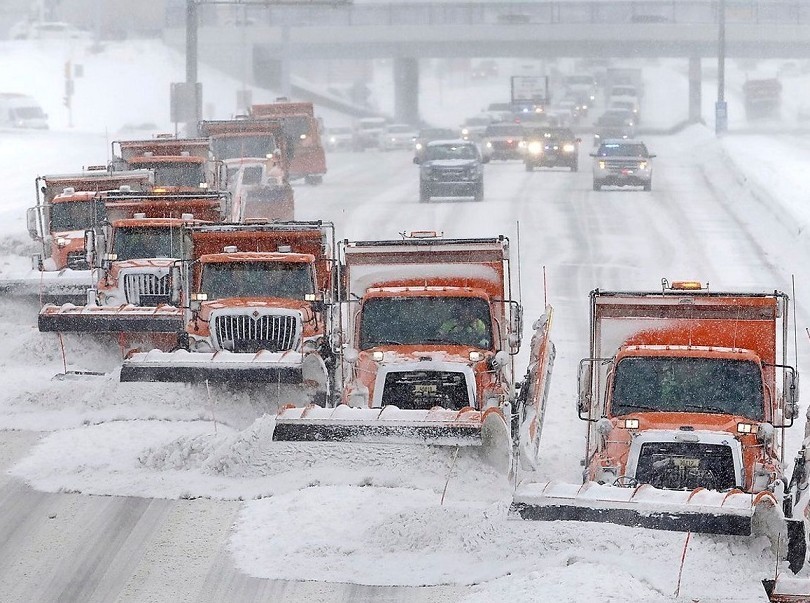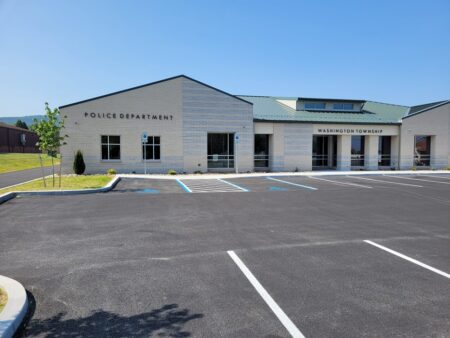HARRISBURG- Ahead of anticipate snow across the state overnight into tomorrow, the Pennsylvania Department of Transportation (PennDOT) and Pennsylvania Turnpike Commission (PTC) are advising motorists to avoid unnecessary travel during the storm. Additionally, the agencies will implement various speed and vehicle restrictions throughout the storm.
PennDOT and PTC crews are actively pre-treating roadways where necessary ahead of the storm to help prevent ice from forming a bond with the pavement during the early stages of a storm. However, salt does not resolve all risks, and drivers may encounter icy spots on the roadway. With freezing temperatures, roads that look wet may actually be icy, and extra caution is needed when approaching bridges and highway ramps where ice can form.
Restrictions will be communicated via variable message boards, the 511PA traveler information website and smartphone apps. Motorists can also sign up for personalized alerts on the website.
The following vehicle restrictions will go into effect at 3:00 AM on Tuesday, February 13, in accordance with the commonwealth’s weather event vehicle restriction plan. Restrictions will be lifted as quickly as possible when conditions are safe.
- Tier 2:
- PA Turnpike (I-76) from New Stanton (Exit 75) to Breezewood (Exit 161).
- Interstate 78, entire length.
- I-80 from I-79 to milepost 173 (Lamar).
- I-99, entire length.
- U.S. 22 from I-78 to the New Jersey border.
- Route 33, entire length.
- PA Turnpike Northeast Extension (I-476) from I-78 to I-80.
- Tier 4 (no commercial vehicles):
- I-80 from milepost 173 (Lamar) to the New Jersey border.
- I-81 from I-78 to the New York border.
- I-84, entire length.
- I-180, entire length.
- I-380, entire length.
- PA Turnpike Northeast Extension (I-476) from I-80 to Clarks Summit (Exit 130).
Under Tier 2 restrictions, the following vehicles are not permitted on affected roadways:
- Tractors without trailers.
- Tractors towing unloaded or lightly loaded enclosed trailers, open trailers or tank trailers.
- Tractors towing unloaded or lightly loaded tandem trailers.
- Tractors towing loaded tandem trailers without chains or Alternate Traction Devices (ATDs).
- Enclosed unloaded or lightly loaded cargo delivery trucks/box trucks that meet the definition of a CMV.
- Passenger vehicles (cars, SUV’s, pickup trucks, etc.) towing trailers.
- Recreational vehicles/motorhomes.
- School buses, commercial buses and motor coaches, regardless of the availability of trains or ATDs.
- Motorcycles.
Tire chains or ATDs do not need to be installed under Tier 2 restrictions but need to be readily available for use should the vehicle become stuck and not be able to move because of poor traction.
On roadways with Tier 4 restrictions in place, no commercial vehicles are permitted. Additionally, all school buses, commercial buses, motor coaches, motorcycles, RVs/motorhomes and passenger vehicles (cars, SUVs, pickup trucks, etc.) towing trailers are not permitted on affected roadways while restrictions are in place.
On roadways where vehicles are not restricted, commercial vehicle drivers in particular are encouraged to exercise caution in high winds. Drivers should ensure their loads are secure, reduce speeds, increase following distance, and use flashers if necessary.
To help make decisions regarding winter travel, motorists are encouraged to “Know Before You Go” by checking conditions on more than 40,000 roadway miles, including color-coded winter conditions on 2,900 miles, by visiting www.511PA.com. 511PA, which is free and available 24 hours a day, provides traffic delay warnings, weather forecasts, traffic speed information and access to more than 1,000 traffic cameras. Users can also see plow truck statuses and travel alerts along a specific route using the “Check My Route” tool. If you are traveling on the PA Turnpike and find yourself in need of assistance, dial *11 on your cell phone. As needed, a staff member of the turnpike’s 24/7 operations center can then dispatch help to your location.
511PA is also available through a smartphone application for iPhone and Android devices, by calling 5-1-1, or by following regional X alerts.
Drivers should prepare or restock their emergency kits with items such as non-perishable food, water, first-aid supplies, warm clothes, a blanket, cell phone charger and a small snow shovel. Motorists should tailor their kits to any specific needs that they or their families have such as baby supplies, extra medication, and pet supplies.
When winter weather occurs, drivers should be extra cautious around operating snow-removal equipment. When encountering a plow truck, drivers should:
- Stay at least six car lengths behind an operating plow truck and remember that the main plow is wider than the truck.
- Be alert since plow trucks generally travel much more slowly than other traffic.
- When a plow truck is traveling toward you, move as far away from the center of the road as is safely possible, and remember that snow can obscure the actual snow plow width.
- Never try to pass or get between several trucks plowing side by side in a “plow train.” The weight of the snow thrown from the plow can quickly cause smaller vehicles to lose control, creating a hazard for nearby vehicles.
- Never travel next to a plow truck since there are blind spots where the operator can’t see, and they can occasionally be moved sideways when hitting drifts or heavy snowpack.
- Keep your lights on to help the operator better see your vehicle. Also remember that under Pennsylvania state law, vehicle lights must be on every time a vehicle’s wipers are on due to inclement weather.
Last winter in Pennsylvania, preliminary data shows that there were 135 crashes resulting in one fatality and 61 injuries on snowy, slushy, or ice-covered roadways where aggressive-driving behaviors such as speeding or making careless lane changes were factors.
The Pennsylvania State Police offers this advice if you are involved in a crash:
- First and foremost, move your vehicle as far as possible from the travel lanes if it’s able to be driven. Remaining in the lanes of travel when your vehicle can be driven is extremely dangerous.
- If your vehicle or another involved vehicle is not able to be driven due to damage, or if one of the involved parties is injured, PA law requires the crash be reported to police. Do this by dialing 911 right away.
- If your vehicle is disabled in the lane of travel or stuck in the travel lanes due to snow or ice, remain inside the vehicle with your seatbelt on and hazard lights activated. If it’s not safe to remain inside your vehicle, assess the situation and get yourself and passengers to a place of safety such as behind a barrier or guardrail. When exiting your vehicle, move as quickly as possible and DO NOT remain in the travel lanes or near your vehicle.
- When encountering a crash scene, the law requires you to move over if possible and always slow down. First responders will be active at the scene and focused on helping those involved in the crash and getting the road back open.
Motorists are reminded the law requires drivers to remove accumulated ice or snow from their vehicle, including the hood, trunk, and roof within 24 hours after the storm has ended. This applies to all vehicles, including commercial vehicles. Drivers in violation of the law are subject to a fine of $50. Additionally, motorists can be cited up to $1,500 if snow or ice is dislodged and strikes another vehicle or pedestrian causing death or serious injury.
For more information on safe winter travel, an emergency kit checklist and information on PennDOT’s winter operations including a video, visit www.PennDOT.gov/winter. Additional winter driving and other highway safety information is available at www.PennDOT.gov/safety.
Follow the conversation by using #PAWinter on X and like the department on Facebook and Instagram.





















